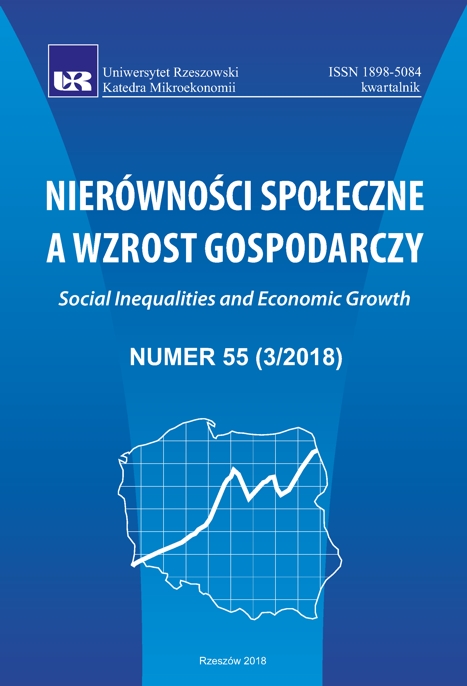Produktywność pracy jako miernik spójności ekonomicznej i społecznej w kraju
DOI:
https://doi.org/10.15584/nsawg.2018.3.17Słowa kluczowe:
produktywność pracy, wzrost gospodarczy, spójność ekonomiczno-społeczna, analityczna funkcja produkcji, nierówności gospodarczeAbstrakt
W pierwszej części artykułu zaprezentowano dyskusję na temat problematyki definiowania i pomiaru wzrostu gospodarczego oraz spójności ekonomicznej i społecznej. W dalszej, metodologicznej części artykułu przedstawiono wskaźnik produktywności pracy, jako propozycję alternatywnej miary rozwoju społeczno-gospodarczego oraz spójności społecznej, ekonomicznej i terytorialnej. Wskaźnik ten przede wszystkim stanowi informację na temat kapitału instytucjonalno-intelektualnego, czyli zdolności gospodarki do tworzenia dobrych instytucji. Gospodarka oparta jest na pracy, a na produktywną pracę pozwala odpowiednio rozwinięty instytucjonalnie system gospodarczy. Wskaźnik ten integruje zarówno poziom technicznego uzbrojenia pracy, rotacji aktywów, rentowności aktywów oraz poziomu opłacenia pracy. Część ostatnią, empiryczną stanowią wyniki analizy produktywności pracy, regionalnego zróżnicowania produktywności pracy oraz relacji między poziomem produktywności kraju a poziomem zróżnicowania regionalnej produktywności pracy w pięciu europejskich krajach. Z badań wynika, że prezentowany wskaźnik jest łatwy w interpretacji i może stanowić podstawę tworzenia wiarygodnych rankingów państw. Ponadto wyniki badań wskazują, że wskaźnik produktywności pracy może stanowić alternatywną miarę spójności ekonomicznej. Wykazano bowiem silną odwrotną korelację między wartością wskaźnika a jego zróżnicowaniem regionalnym. Zatem wskaźnik ten może służyć pomiarowi zakresu realizacji paradygmatu zrównoważonego wzrostu.Downloads
Download data is not yet available.
Pobrania
Opublikowane
2020-11-13
Jak cytować
Kozioł, W. (2020). Produktywność pracy jako miernik spójności ekonomicznej i społecznej w kraju. Nierówności Społeczne a Wzrost Gospodarczy, 3(55), 257–269. https://doi.org/10.15584/nsawg.2018.3.17
Numer
Dział
Artykuły
Licencja
Prawa autorskie (c) 2018 Uniwersytet Rzeszowski

Utwór dostępny jest na licencji Creative Commons Uznanie autorstwa – Na tych samych warunkach 4.0 Miedzynarodowe.


